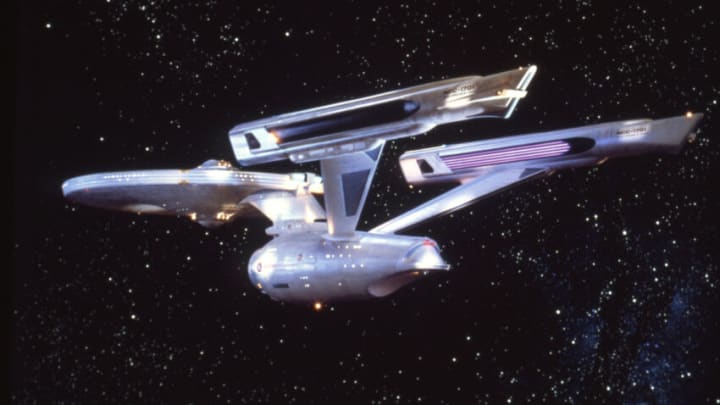“The Immunity Syndrome” turns 55 years old this week.
Fifty-five years ago this week, on January 19, 1968, the original Star Trek series on NBC returned from its mid-second season break with “The Immunity Syndrome.” Original series fans tend to recall “The Immunity Syndrome” as “the one with the space amoeba.” An enormous single-celled organism has invaded our galaxy. It’s up to the crew of the Enterprise to stop it before it reproduces. (Spoiler alert: They succeed.)
Robert Sabaroff wrote “The Immunity Syndrome.” It was his first Star Trek assignment, though he didn’t return to the franchise until The Next Generation’s first season, writing the story and script for “Home Soil,” and writing the story for “Conspiracy.” Joseph Pevney directed it—the last of his 14 Star Trek directorial jobs.
“The Immunity Syndrome” is a solid, serviceable “bottle show,” taking place entirely on pre-existing, shipboard sets (the Enterprise and Galileo shuttle interiors). It doesn’t include any series-shaping or character-changing moments—which, given the nature of 1960s episodic television, were always few and far between in the original series.
But “The Immunity Syndrome” may have made a bigger impact on the franchise than generally realized.
“The Immunity Syndrome” set a pattern for Star Trek: The Motion Picture
Were you to ask Star Trek fans which original episode Star Trek: The Motion Picture most resembles, they’d answer “The Changeling.” And with good reason. Both stories are about encounters with space probes from 20th-century Earth that have changed in deep space and are on catastrophic quests for their creators.
But whether by coincidence or design, Star Trek: The Motion Picture also bears several striking similarities to “The Immunity Syndrome.” Here are five to consider:
- Spock experiences a telepathic disturbance early on.
In The Motion Picture, Spock senses Vejur’s consciousness calling to him from space. In “The Immunity Syndrome,” he “hears” in his mind “the death scream of four hundred Vulcan minds crying out over the distance” as the space organism destroys their ship, the Intrepid. In both stories, Spock’s Vulcan mental capacities allow the writers to serve up attention-getting inciting incidents.
- The Enterprise travels deep into big, unknown space anomalies.
In The Motion Picture, the Enterprise journeys into the enormous, luminous cloud surrounding Vejur—as few as two and as many as 82 AUs in diameter, depending upon which version of the film you’re watching. In “The Immunity Syndrome,” the Enterprise delves into a “zone of darkness” and “zone of energy” described as some 11,000 miles (17,703 km) long and 2,000-3,000 miles (3,218-4,828 km) wide. The amoeba’s no match for Vejur when it comes to size, but both are large regions of mystery through which it takes some time to travel.
- Captain Kirk gets testy and pushes his people.
In The Motion Picture, the urgent threat Vejur presents coupled with Kirk’s “obsession” with commanding the Enterprise leads Kirk to treat his officers, especially Decker, with an unusually hard nose. At one point, McCoy must warn him, “Jim, you’re pushing. Your people know their jobs.” In “The Immunity Syndrome,” Kirk also fails, at times, to show grace under pressure. For example, exasperated by Spock’s inability to produce a reliable analysis of the “zone of darkness,” Kirk snaps, “Insufficient data is not sufficient . … You’re the science officer, you’re supposed to have sufficient data all the time!” In both stories, we get moments that emphasize Kirk as a realistic, well-rounded character. He’s a good commander, but he’s not perfect.
- Spock searches the heart of each space anomaly alone.
In The Motion Picture, Spock steals a thruster suit so he can enter Vejur’s “inner sanctum,” where he sees a visual representation of its epic journey, and where he mind melds with Vejur. The experience nearly kills him. In “The Immunity Syndrome,” Kirk reluctantly countenance Spock’s solitary exploration, but taking the Galileo into the organism’s nucleus likewise nearly proves fatal, as he is drained of his life force. Both stories present Spock as uniquely qualified to bring the unknown to light.
- Spock and McCoy give each other guff (good-natured or otherwise).
In The Motion Picture, we see McCoy and Spock taking digs at each other—some friendly (“So help me, I’m actually glad to see you”) and some less so (their exchanges in the officer’s lounge)—as they did throughout the series. In “The Immunity Syndrome,” the two positively bicker with each other about who’s best qualified to explore the organism’s nucleus. And in Act One, Spock delivers two back-to-back “burns” of Bones, and the human race, that rank among the series’ most memorable.
"SPOCK: I’ve noticed that about your people, Doctor. You find it easier to understand the death of one than the death of a million. You speak about the objective hardness of the Vulcan heart, yet how little room there seems to be in yours.McCOY: Suffer the death of thy neighbor, Spock? You wouldn’t wish that on us, would you?SPOCK: It might have rendered your history a bit less bloody."
Celebrate the 55th anniversary of “The Immunity Syndrome” with a rewatch of your own this week, and see if you can find other ways it set a template for The Motion Picture, or other Star Trek adventures, to follow!
CORRECTION: This article misidentifies “The Immunity Syndrome” as the first episode aired in January 1968. “The Gamesters of Triskelion” aired January 5, 1968.
